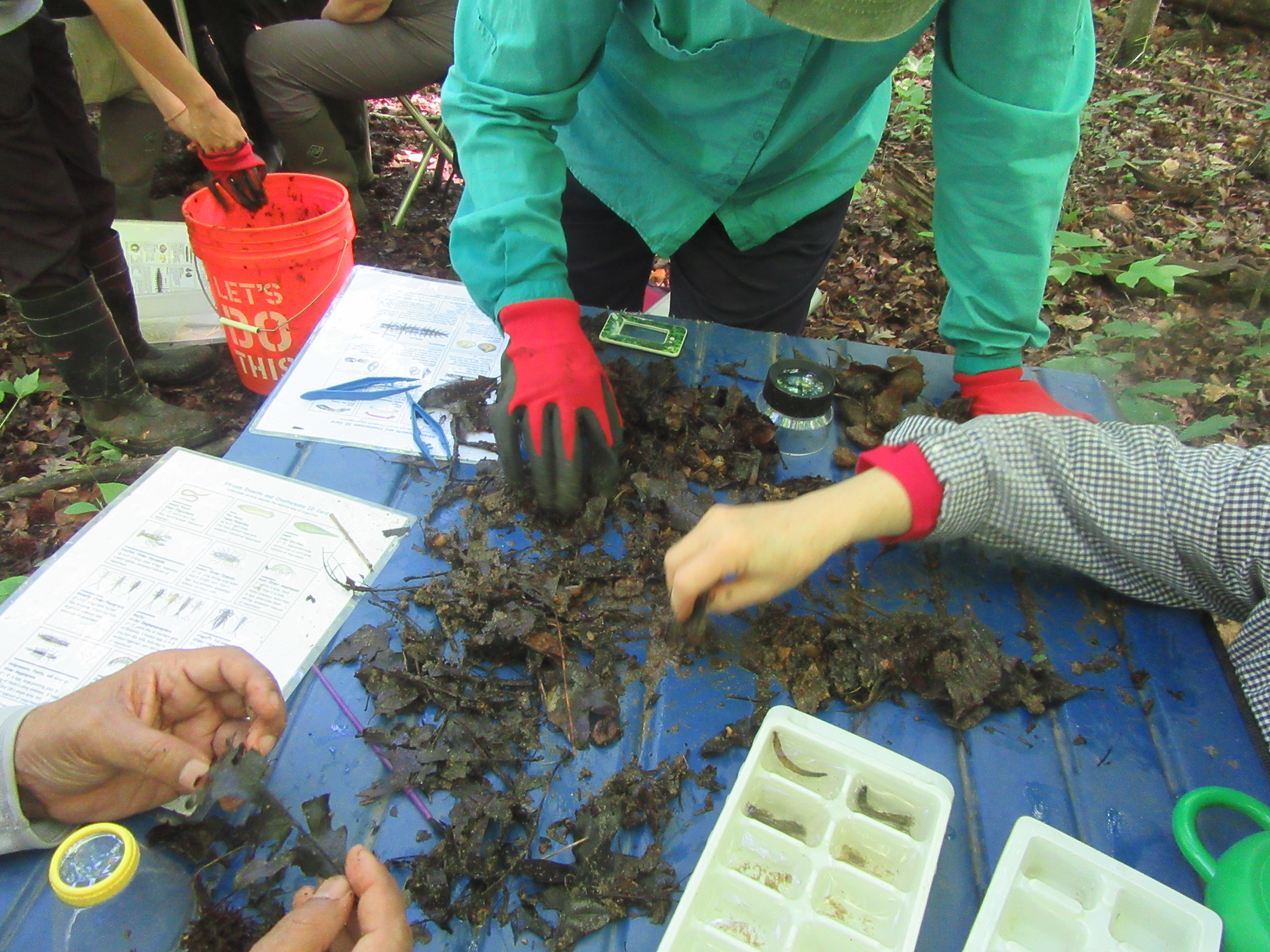Ashley Palmer supervises water quality monitoring for the Northern Virginia Soil and Water Conservation District.
“I saw a wiggle,” Ashley Palmer told 14 volunteers as they scratched through soggy stream sediments, adding that most of the organisms would be eyelash size.
Since 2016, Palmer and volunteer teams have collected samples from the bed of the unnamed stream that flows through Mount Vernon Park, Westgrove Dog Park, River Towers Condominiums property and into Dyke Marsh. Palmer supervises stream monitoring for the Northern Virginia Soil and Water Conservation District (NVSWCD).
The volunteers take 20 samples within a 300-foot span, seeking to identify 100 living invertebrates. What type of Invertebrates are found in a stream are an indicator of stream quality. Some species are tolerant of pollution and degraded environments and others are very sensitive. “We want 100 non-scuds,” Palmer said, because scuds tolerate unhealthy habitats.
With around 85 volunteers, the NVSWCD does water sampling at nine sites, including Pohick, Accotink and Wolftrap Creeks.

Volunteers search through the sediments for invertebrates.
Mixed Results
The water quality scoring scale is 0 to 24, with 24 being a healthy stream. A stream that scores less than eight is considered to be in an ecologically unacceptable condition. A score of eight to 14 is in partially acceptable condition; greater than 14, acceptable.
On May 16 the group collected 84 organisms and the score was nine, which Palmer said is an “indeterminate ecological stream score.” On April 11, they collected 146 organisms and the stream scored 18, which tied for the highest number ever recorded at the site over nine years.
Particularly captivating was a one-quarter to one-half inch long casemaker caddisfly tube, which looked like a miniscule stick. Its larvae make tiny tubes of leaves. Volunteers watched the insect emerge from its protective case. These are highly sensitive to pollution and found infrequently in the county.
This stream is both intermittent and ephemeral, fed by stormwater overflow from upstream development and from underground springs. Palmer calls it a “muddy bottom stream,” in contrast to many other county waterways that have rocky bottoms. The group collected samples from the streambanks, woody debris, riffles and submerged aquatic vegetation.
In a 2023 report, Palmer wrote, “It’s very likely that one of the main reasons (if not the main reason) for the creek’s low numbers of organisms is that it dries up in summer and fall. It is important to note that although the number of organisms found at QC1 [this stream] are few, monitors have seen many species at the site which indicate promise. QC1 often holds both dragonfly and damselfly nymphs which are predators in the aquatic food web, indicating stability in prey populations.”
That report concluded that the creek “is in poor ecological health. A healthy stream is abundant in both quantity and biodiversity of macroinvertebrates, which serve many important functions in aquatic food webs …” Palmer urges continued monitoring “because it is a tributary to Dyke Marsh and one of the ways to check in on the health of Dyke Marsh is to monitor the small streams that feed into it. This creek has experienced erosion in the past and it’s important to keep an eye out for indicators for this problem arising in the future.”
Fairfax County Streams Degraded
County data show that 83 percent of Fairfax County's streams were in fair to very poor condition in 2023, significantly impaired and lacking biological diversity.
One cause of poor water quality is polluted stormwater runoff, the only growing source of pollution to the Potomac River according to the Potomac Conservancy.
Impervious surfaces like roads, roofs and parking lots prevent rainwater from entering the soil. The water carries pollutants from those surfaces, like oils, metals and pesticides. “When impervious surfaces reach 10 to 20 percent of a local watershed area, surface runoff doubles and continues to increase until, at 100 percent impervious surface coverage, runoff is five times that of a forested watershed,” according to the U.S. Environmental Protection Agency.
If a watershed is as little as 2.5 percent impervious surfaces, stream invertebrate communities start to change, according to the Smithsonian Environmental Research Center.
The Little Hunting Creek Watershed Plan, completed in 2005, indicates that 25 percent of the watershed was impervious then. The 2007 Cameron Run Watershed Plan reported that each subwatersheds’ imperviousness exceeds 23 percent, that “greater than 10 percent imperviousness has been shown to significantly diminish habitat quality and biological integrity in steam systems.” Given expanding development since those assessments, impervious cover has no doubt expanded. County officials did not provide more recent numbers.
On county streams’ condition, Board of Supervisors Chairman Jeff McKay said, “Fairfax County is dedicated to enhancing the health of our streams through numerous projects and initiatives. We employ a team of ecologists to collect data through the Stream Quality Assessment Program, enabling us to monitor trends and make informed decisions. Through stream bank restoration efforts, we are providing essential plants to help filter rainwater, ensuring the protection of our waterways. There are several ongoing stream restoration projects actively working to restore over 16 miles of stream banks throughout the County. This is in addition to the numerous other stormwater management projects around the County. To see a list of all stormwater projects we currently have in the County, visit https://www.fairfaxcounty.gov/publicworks/stormwater/stormwater-improvement-projects.”
More Information
www.fairfaxcounty.gov/publicworks/stormwater/stream-quality-assessment-program
www.cleanwaterhub.org/organization/97
